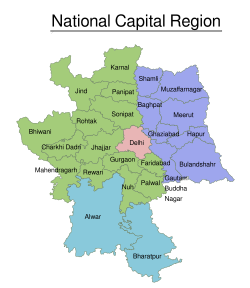Heavy rainfall struck Delhi and adjoining National Capital Region areas early Sunday, causing significant waterlogging and disrupting normal life across the capital. The intense downpour overwhelmed drainage systems, leading to flooded streets and traffic snarls that affected millions of commuters throughout the morning.
Delhi’s Indira Gandhi International Airport experienced operational challenges as weather conditions deteriorated. Between 11:30 PM Saturday and 4:00 AM Sunday, authorities diverted at least 49 flights, including 17 international flights, to alternate airports to ensure passenger safety and manage air traffic amid low visibility and wet runways. The airport remained operational but faced delays and rescheduling, impacting travellers domestically and abroad.
Several key arterial roads and residential localities in Delhi bore the brunt of the flooding, with water levels rising rapidly in low-lying zones such as Dwarka, Rohini, and parts of South Delhi. Commuters reported long delays and stalled vehicles, while emergency services worked to clear drain blockages and pump out accumulated water. City officials issued advisories urging residents to avoid unnecessary travel and remain vigilant during the ongoing inclement weather.
The India Meteorological Department had forecast heavy rains over Delhi and NCR, attributing the intense precipitation to a Western Disturbance combined with moisture from the Bay of Bengal and Arabian Sea. This rare combination amplified rainfall intensity and duration, overwhelming infrastructure designed primarily for moderate monsoon showers.
Meteorologists noted that the heavy rainfall was part of a broader weather pattern impacting northern India, with several adjoining states also recording above-average precipitation. Experts cautioned that such extreme weather events may become more frequent due to shifting climate patterns, stressing the need for enhanced urban planning and resilient infrastructure.
Delhi’s stormwater drainage system, often criticised for inadequate maintenance and limited capacity, struggled to cope with the volume of rainwater. Many drains were clogged with debris, exacerbating flooding and increasing the risk of waterborne diseases. Public health officials warned about stagnant water potentially serving as breeding grounds for mosquitoes and urged swift action to clean drainage channels.
Traffic police reported multiple accident cases on slippery roads, including minor collisions and skidding incidents. They urged drivers to exercise caution and adhere to reduced speed limits amid the hazardous conditions. Several schools and offices in flood-affected areas delayed opening hours or closed temporarily as a precaution.
The heavy rain disrupted power supply in some parts of Delhi, with several neighbourhoods experiencing outages due to waterlogged electrical substations and snapped cables. Electricity distribution companies deployed repair crews promptly to restore services and prevent further disruption.
Delhi’s civic bodies initiated emergency response measures by deploying additional water pumps and rescue teams to critical locations. Municipal workers cleared drains, removed debris, and worked overnight to alleviate flooding. However, many residents expressed frustration over recurring waterlogging issues during the monsoon, highlighting gaps in urban flood management.
Public transport services, including the Delhi Metro and bus networks, adjusted operations to accommodate delays caused by waterlogged roads. Metro officials reported smooth functioning despite challenges accessing certain stations affected by surface flooding.
The impact on air travel at Indira Gandhi International Airport highlighted vulnerabilities in critical transport infrastructure during extreme weather. Officials reviewed contingency plans and coordination with air traffic control to minimise passenger inconvenience while maintaining safety standards.
The rainfall underscored the challenges Delhi faces in adapting to increasingly unpredictable weather patterns linked to climate change. Experts emphasise the importance of integrated urban planning that incorporates sustainable drainage solutions, increased green spaces, and improved emergency preparedness.
Government agencies have announced plans to accelerate the upgrade of drainage networks, including installing additional pumping stations and desilting existing drains. Efforts are underway to enhance real-time weather monitoring and communication systems to better inform the public and authorities about impending weather threats.




 India Rallies Global Support Against Cross-Border Terrorism
India Rallies Global Support Against Cross-Border Terrorism 